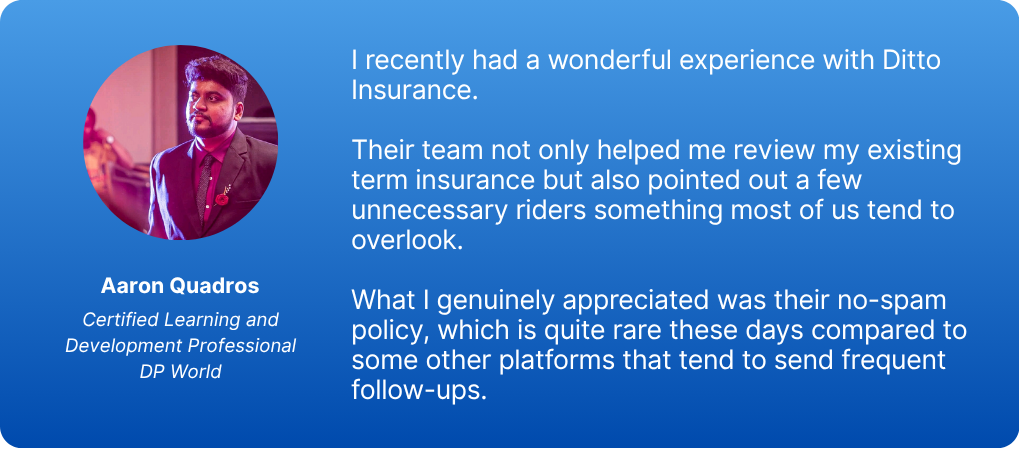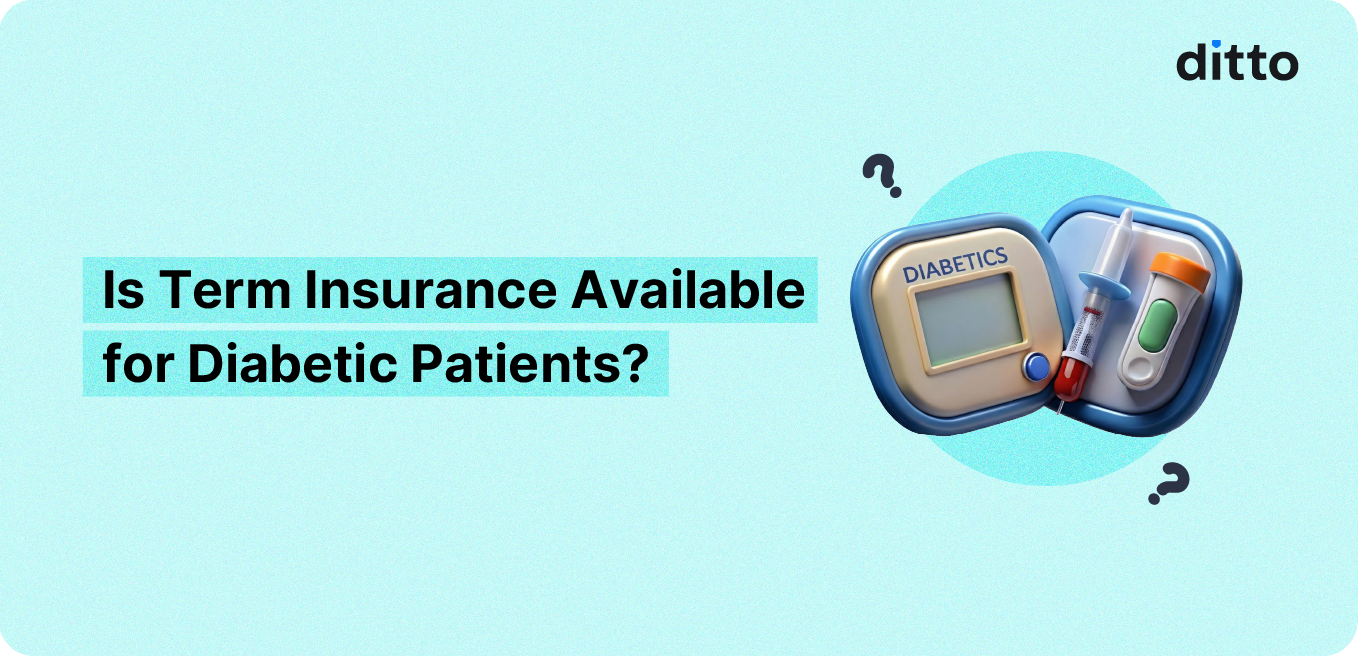Is Term Insurance Available for Diabetic Patients?
Many diabetics start their term insurance journey without knowing how their condition affects eligibility, premiums, or underwriting decisions. The reality is that insurers may increase premiums by 25 to 100 %, postpone the application, or reject it entirely.
At Ditto, we’ve worked with over 1,000 diabetic applicants in the past year and reviewed hundreds of underwriting outcomes. What matters most is your type of diabetes, HbA1c levels, how long you’ve lived with the condition, and how stable your treatment is.
This guide breaks down what to expect and how to improve your chances of getting approved at a fair price.
How Do Types of Diabetes Affect Term Insurance?
Insurers treat diabetes as a long-term medical condition that can increase the risk of heart, kidney, and nerve-related complications. As a result, there is a strict underwriting process, and every diabetes type is assessed differently.
- Type 1 Diabetes
- Usually declined due to early onset and lifelong insulin dependence.
- Insurers consider it a high-risk profile because complications can develop over time.
- Type 2 Diabetes
- Insurers show more flexibility with Type 2 diabetes because it can often be managed with medication and lifestyle control.
- Approval depends on HbA1c levels, duration since diagnosis, treatment method, BMI, blood pressure, and presence of any complications.
- Well-controlled Type 2 cases are generally accepted with premium loading charges.
How Insurers Review Diabetic Profiles and Their Outcomes
Here’s a simple overview of the underwriting outcomes we typically see when BMI, blood pressure, and other markers are within normal ranges.
Disclaimer: These outcomes are based on real-life cases handled by Ditto. Final decisions depend on each insurer’s underwriting guidelines.
Benefits of Term Insurance for Diabetics
- Financial security for your Family
You can secure a high sum assured at relatively affordable premiums, even if a loading charge is applied. This ensures your family has a financial safety net in your absence. - Tax benefits under Section 80C
Premiums paid toward your term plan are eligible for tax deductions of up to ₹1.5 lakh under Section 80C (under the old regime). - Access to essential riders (depending on your profile):
Insurers may restrict health-based riders for diabetics, such as Critical Illness, Waiver of Premium on illness, and Hospital Cash. However, many still qualify for key add-ons like Accidental Death Benefit, Waiver of Premium on Accidental Disability, and Terminal Illness Benefit, which strengthen overall protection. - Long-term peace of mind:
Once your policy is issued, your family is guaranteed the full sum assured, regardless of how your diabetes progresses later.

Benefits of Term Insurance for Diabetics
Financial Security For Your Family
You can secure a high sum assured at relatively affordable premiums, even if a loading charge is applied. This ensures your family has a financial safety net in your absence.
Tax Benefits Under Section 80C
Premiums paid toward your term plan are eligible for tax deductions of up to ₹1.5 lakh under Section 80C (under the old regime)
Access to Essential Riders (Depending on Your Profile)
Insurers may restrict health-based riders for diabetics, such as Critical Illness, Waiver of Premium on illness, and Hospital Cash. However, many still qualify for key add-ons like Accidental Death Benefit, Waiver of Premium on Accidental Disability, and Terminal Illness Benefit, which strengthen overall protection.
Long-term Peace of Mind
Once your policy is issued, your family is guaranteed the full sum assured, regardless of how your diabetes progresses later.
Popular Term Insurance Plans for Diabetics (Ditto’s Cut)
Before we list the plans, know that each is chosen using Ditto’s six-point framework covering coverage, exclusions, claims, pricing, policy terms, and long-term value because they consistently score well across all pillars.
For well-controlled Type 2 diabetics, several insurers offer strong approval chances.
1) Axis Max Life Smart Term Plan Plus (STPP)
This plan generally offers a smoother journey for well-controlled Type 2 diabetics. Max Life tends to be more flexible in underwriting when key health markers like HbA1c, sugar levels, and blood pressure are stable. The plan also delivers strong value with practical features that enhance protection and flexibility.
Key Features:
- Total and Permanent Disability rider
- Zero Cost Option (walk away early without losing your money)
- Terminal Illness benefit
2) HDFC Life Click2Protect Supreme
This is a strong, dependable plan backed by HDFC Life’s consistent claim performance, high solvency ratios, and stable operational track record. It also works well for diabetics who want spouse cover and flexibility in customising their protection.
Key Features:
- Total Permanent Disability cover
- Zero Cost Option
- Spouse Cover
- Life Stage Benefit
3) ICICI Prudential iProtect Smart Plus
ICICI Pru often takes a favourable view of well-controlled Type 2 cases, especially when HbA1c is stable. The plan also offers several practical benefits that appeal to many buyers.
Key Features:
- Life Stage Benefit (increase cover as responsibilities grow)
- Accidental Death Benefit
- Instant Payout on claim intimation
- Smart Exit Option
4) Bajaj Allianz e-Touch II
If affordability is a priority, this is often one of the best plans for Type 2 diabetics. It’s clean, simple, and usually more budget-friendly than other plans, even after loading charges are applied.
Key Features:
- Terminal illness benefit
- Waiver of premium on disability
- Accidental Death Benefit rider
5) Aditya Birla Sun Life Super Term Plan
An affordable, feature-rich plan from Aditya Birla with discounts for salaried applicants and women, supported by the insurer’s solid track record and dependable performance metrics.
Key Features:
- Inbuilt terminal illness payout
- Premium waiver on ATPD
- Cover adjustments based on changing Life Stage needs
- Cover Continuance (premium deferment up to 12 months)
- Early Exit option
How Much More Do Diabetics Pay for Term Insurance?
Diabetics usually pay a higher premium because insurers add a loading charge. This is typically:
- 25–50% extra for well-controlled cases
- 75–100% or more for older applicants or those with long-standing diabetes or complications
So, if a healthy person pays ₹10,000 per year, a diabetic may pay:
- ₹12,500–15,000 if well controlled
- ₹17,500 or more for higher-risk profiles
These numbers are approximate but reflect common underwriting outcomes.
Key Metrics Comparison of Term Insurance Plans for Diabetics
Why Choose Ditto for Term Insurance?
At Ditto, we’ve assisted over 8,00,000 customers with choosing the right insurance policy. Why customers like Aaron below love us:

- No-Spam & No Salesmen
- Rated 4.9/5 on Google Reviews by 15,000+ happy customers
- Backed by Zerodha
- 100% Free Consultation
You can book a FREE consultation. Slots are running out, so make sure you book a call now!
Ditto’s Take on Term Insurance for Diabetics
From our experience, a few patterns are clear:
- Type 1 diabetes is almost always declined, even if insurers claim to evaluate it on a case-by-case basis. The long-term risks and insulin dependence make approvals extremely unlikely.
- Type 2 diabetes is typically approved when controlled, but expect a premium loading charge.
- HbA1c levels, insulin usage, and the presence of complications (like neuropathy or hypertension) largely shape the final decision of insurers.
- Timing is crucial, so apply only when your medical reports are stable.
- Avoid applying during fluctuating sugar levels or right after medication changes, as this often leads to postponements or rejections.
Term insurance for diabetics is completely possible, but it requires more preparation and consistently stable health parameters than a standard application.
If you’re unsure whether you’ll qualify for a term plan as a diabetic, book a free call with our advisors.
Frequently Asked Questions
Last updated on:










